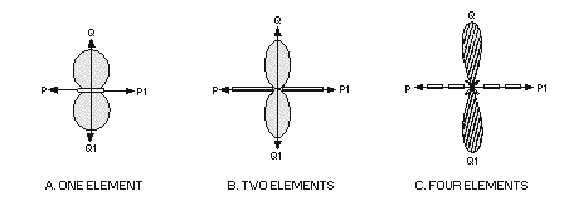4-30
PP1 axis. QQ1 represents the line of maximum propagation. You can see that radiation is stronger with an
added element. The pattern in view B is sharper, or more directive, than that in view A. This means that
the gain along the line of maximum energy propagation is increased and the beam width is decreased. As
more elements are added, the effect is heightened, as shown in view C. Unimportant minor lobes are
generated as more elements are added.
Figure 4-25.—Single half-wave antenna versus two half-wave antennas in phase.
More than four elements are seldom used because accumulated losses cause the elements farther
from the point of feeding to have less current than the nearer ones. This introduces an unbalanced
condition in the system and impairs its efficiency. Space limitations often are another reason for
restricting the number of elements. Since this type of array is in a single line, rather than in a vertically
stacked arrangement, the use of too many elements results in an antenna several wavelengths long.
RADIATION PATTERN.—The characteristic radiation pattern of a given array is obtained at the
frequency or band of frequencies at which the system is resonant. The gain and directivity characteristics
are lost when the antenna is not used at or near this frequency and the array tunes too sharply. A collinear
antenna is more effective than an end-fire array when used off its tuned frequency. This feature is
considered when transmission or reception is to be over a wide frequency band. When more than two
elements are used, this advantage largely disappears.
LENGTH AND PHASING.—Although the 1/2 wavelength is the basis for the collinear element,
you will find that greater lengths are often used. Effective arrays of this type have been constructed in
which the elements are 0.7 and even 0.8 wavelength long. This type of array provides efficient operation
at more than one frequency or over a wider frequency range. Whatever length is decided upon, all of the
elements in a particular array should closely adhere to that length. If elements of different lengths are
combined, current phasing and distribution are changed, throwing the system out of balance and seriously
affecting the radiation pattern.
Q28. What is the maximum number of elements ordinarily used in a collinear array?
Q29. Why is the number of elements used in a collinear array limited?
Q30. How can the frequency range of a collinear array be increased?
Q31. How is directivity of a collinear array affected when the number of elements is increased?
SPACING.—The lower relative efficiency of collinear arrays of many elements, compared with
other multi-element arrays, relates directly to spacing and mutual impedance effects. Mutual impedance is



